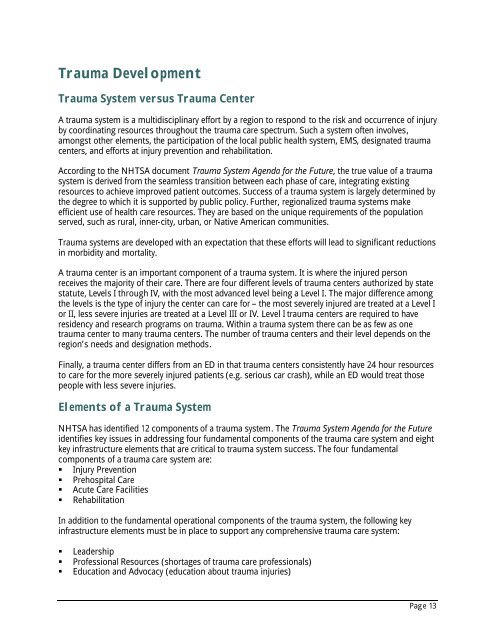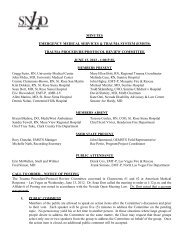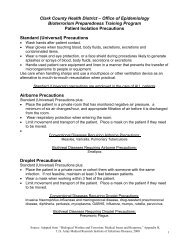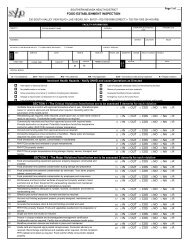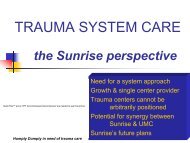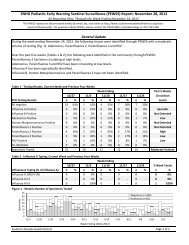Current Trauma Status Report - Southern Nevada Health District
Current Trauma Status Report - Southern Nevada Health District
Current Trauma Status Report - Southern Nevada Health District
Create successful ePaper yourself
Turn your PDF publications into a flip-book with our unique Google optimized e-Paper software.
<strong>Trauma</strong> Development<br />
<strong>Trauma</strong> System versus <strong>Trauma</strong> Center<br />
A trauma system is a multidisciplinary effort by a region to respond to the risk and occurrence of injury<br />
by coordinating resources throughout the trauma care spectrum. Such a system often involves,<br />
amongst other elements, the participation of the local public health system, EMS, designated trauma<br />
centers, and efforts at injury prevention and rehabilitation.<br />
According to the NHTSA document <strong>Trauma</strong> System Agenda for the Future, the true value of a trauma<br />
system is derived from the seamless transition between each phase of care, integrating existing<br />
resources to achieve improved patient outcomes. Success of a trauma system is largely determined by<br />
the degree to which it is supported by public policy. Further, regionalized trauma systems make<br />
efficient use of health care resources. They are based on the unique requirements of the population<br />
served, such as rural, inner-city, urban, or Native American communities.<br />
<strong>Trauma</strong> systems are developed with an expectation that these efforts will lead to significant reductions<br />
in morbidity and mortality.<br />
A trauma center is an important component of a trauma system. It is where the injured person<br />
receives the majority of their care. There are four different levels of trauma centers authorized by state<br />
statute, Levels I through IV, with the most advanced level being a Level I. The major difference among<br />
the levels is the type of injury the center can care for – the most severely injured are treated at a Level I<br />
or II, less severe injuries are treated at a Level III or IV. Level I trauma centers are required to have<br />
residency and research programs on trauma. Within a trauma system there can be as few as one<br />
trauma center to many trauma centers. The number of trauma centers and their level depends on the<br />
region’s needs and designation methods.<br />
Finally, a trauma center differs from an ED in that trauma centers consistently have 24 hour resources<br />
to care for the more severely injured patients (e.g. serious car crash), while an ED would treat those<br />
people with less severe injuries.<br />
Elements of a <strong>Trauma</strong> System<br />
NHTSA has identified 12 components of a trauma system. The <strong>Trauma</strong> System Agenda for the Future<br />
identifies key issues in addressing four fundamental components of the trauma care system and eight<br />
key infrastructure elements that are critical to trauma system success. The four fundamental<br />
components of a trauma care system are:<br />
• Injury Prevention<br />
• Prehospital Care<br />
• Acute Care Facilities<br />
• Rehabilitation<br />
In addition to the fundamental operational components of the trauma system, the following key<br />
infrastructure elements must be in place to support any comprehensive trauma care system:<br />
• Leadership<br />
• Professional Resources (shortages of trauma care professionals)<br />
• Education and Advocacy (education about trauma injuries)<br />
Page 13


